Kutjevo Tourism Project: Partner Sought to Turn Town into Hit
July the 26th, 2022 - A Kutjevo tourism project to turn this continental Croatian town which is well known for its local wine into a tourist hit could well come to fruition. Kutjevo is seeking a partner to whom it will provide a large sum to if they can complete what's necessary for the vision.
As Poslovni Dnevnik/Marija Brnic writes, Grasevina House, the centre just like those in some of the largest wine regions in France, Spain and Switzerland, has long been aimed for by Kutjevo's winemakers, and such a project has been being strategically designed and prepared for some time.
Finally, thevery first steps are beginning to be taken, because Kutjevo, as the project holder that will be the basis for the development of gastro-enological tourism in that part of Croatia, has announced a tender for a partner in the preparation of project documentation for this large Kutjevo tourism project.
Grasevina House, an interpretation centre, is expected to be built and arranged on land located in the very centre of Kutjevo, and it would be the perfect addition to this continental town with a rich history which is rightfully proud of its viticulture and winemaking traditions.
Grasevina is originally a Croatian and not an Italian wine variety, as it has been wrongly portrayed, and at the same time it is the most widespread white wine variety in all of Croatia. This variety is a symbol of wine production in Kutjevo, and when it comes to just how important it is for Croatian viticulture, Kutjevo locals state that as much as 27 to 33 percent of the area is covered by the growth of precisely this variety.
They want to bring the rich history and traditions of the production and culture of wine drinking in Kutjevo closer to those interested through a large Kutjevo tourism project, and in designing it, they studied how such museums and centres were organised by the French in Bordeaux, where La Cite du Vin was under construction for three years and opened its doors in 2016. Then came the Vivanco family museum which was opened in Rioja (Spain) back in 2004, and the Valais wine museum, which was established in Switzerland by the local community of winemakers there.
In all these museums, in addition to nurturing the culture of local wine, visitors are offered a much broader content, which Kutjevo wants to apply in its case as well. The Kutjevo tourism project also envisages a gallery space for both permanent and temporary exhibitions, an ethno-bar inside the museum and in the garden, a viewpoint with a view of the vineyards spanning the area, spaces for congresses, seminars and corporate events, as well as celebrations, and much more.
The project documentation will also include Greta Park, a city park named after Greta Turkovic, an area and name important for Croatian wine and art culture, and which is located between the Kutjevo Castle and the future Grasevina House. The Kutjevo tourism project also envisages the organisation of a thematic trail called Vinogradarski put, through which visitors will be able to meet local winemakers and visit their cellars.
Kutjevo is willing to pay 1.5 million kuna plus VAT for the creation of the design and technical documentation, which includes the conceptual solution for the project, the removal of the building, the main and executive design, the preparation of cost estimates and the elaboration for obtaining a building permit, and the tender will remain open until August the 16th, 2022.
They expect the documentation within ten months after the conclusion of the contract, after which they will begin the implementation of the project which, they hope, will include the area on the map of top tourist and cultural destinations.
For more, make sure to check out our dedicated travel section.
Galic Winery Must Return 10 Million Kuna in European Union Funds
August the 22nd, 2021 - Bad news for the well known Galic Winery, which now must return a massive 10 million kuna from the Wine Envelope which was allocated to it.
As Poslovni Dnevnik writes, the Galic Winery, owned by entrepreneur Josip Galic from Kutjevo, must return 10 million kuna from the Wine Envelope allocated to it through the European Agricultural Guarantee Fund for the construction of a new winery building in Kutjevo which was worth seven million euros.
The Agency for Payments in Agriculture, Fisheries and Rural Development, based on the recommendation of the European Anti-Fraud Office (OLAF), recently issued a decision to annul the decision on the Galic Winery project approval and made a decision on the return of paid aid in the amount of 10,047,442.29 kuna, Jutarnji list writes. This is the first such case, according to the same publication.
OLAF stated that during the construction of the winery, there was malversation and abuse in the selection of contractors, ie subcontractors. In this particular case, one of the subcontractors of construction work on the wine cellar was the company Presoflex owned by Ina Galic, the child of Josip Galic.
It should be noted that the Galic Winery hired one company as a contractor, and it then hired five subcontractors, including Galic's child's aforementioned company, which OLAF considers a conflict of interest, explaining that ''the legislative framework prohibits users of EU funds from projects for which they received money to hire companies with which they have personal or business connections,'' reports Jutarnji list.
The Galic Winery has stated that it is shocked by this decision, which they're trying to challenge because they consider it to be illegal. The Agency said that the decision was made “based on Article 33, paragraph 2 of the Ordinance on the implementation of the measure Investments in wineries and wine marketing from the National Wine Sector Assistance Programme 2014-2018, which stipulates that the Paying Agency will request a refund if it is determined that the beneficiary has acted contrary to the provisions of the Ordinance and the rules for the use of such funds for the Investment measure, ie in case of an established irregularity,''
They also stated that during the approval of the now disputed Galic Winery project, as well as during the control of its implementation, the Agency didn't know that a company owned by Galic's offspring was being engaged in the project, and that the beneficiary had previously been instructed in all of the obligations based on the project approval decision.
For more, follow our business section.
PHOTOS: Outstanding Contemporary Croatian Architecture of the Year
February 10, 2021 – 10 of the most outstanding examples of contemporary Croatian architecture have been selected by the Association of Croatian Architects to compete in the extremely prestigious Mies van der Rohe Awards. Held only once every two years, they are the European equivalent of the Pritzker Prize for Architecture.
The Mies van der Rohe Awards are a really big deal. The greatest works of European architecture compete for recognition in the competition. The greatest success of Croatian architecture in the awards was attained by UP studios' Toma Plejić and Lea Pelivan, who received a special award for upcoming architects and had their high school in Koprivnica named the best building in that category in 2009. The success has had a considerable impact on their careers since.
Being held only once every two years, Croatian architecture projects completed since the closure of entries for the 2019 awards are eligible to be submitted. Here are the outstanding examples of contemporary Croatian architecture that will represent the country in 2022.
Cinema Urania Zagreb
An old neighbourhood cinema built into the back streets near Kvatric. In their redesign, 3LHD preserved the best features from this early example of concrete engineering in Croatian architecture. They added a glass pavilion at the entrance, atriums and skylights, flooding the former darkness with the natural light needed for its new purpose as an event and work space. © Jure Živković
© Jure Živković
Grand Park Hotel, Rovinj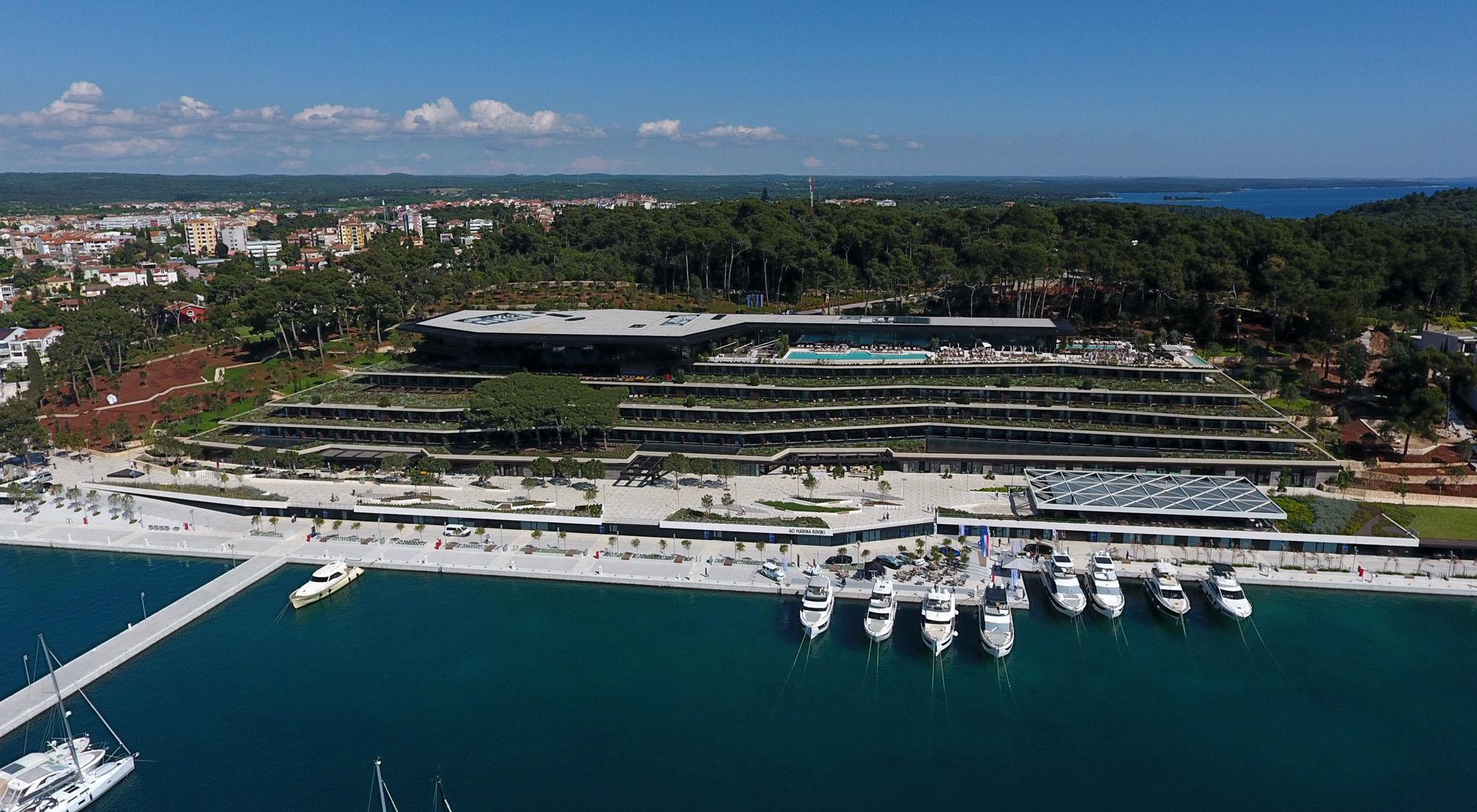
Sprawling widely across six stepped levels, the new luxury Grand Park Hotel and spa could easily have looked a long swipe of concrete. But, by places greenery on each of its staged roofs, architects 3LHD have ensured that no matter where you are in the 500-guest-capacity building, your view places you within a garden, looking out onto Rovinj Old Town and the expanse of the Adriatic. Croatian architecture at its most breathtaking. © Alukoenigstahl hr
© Alukoenigstahl hr
Ivanja Reka Elementary School, south Sesvete, east Zagreb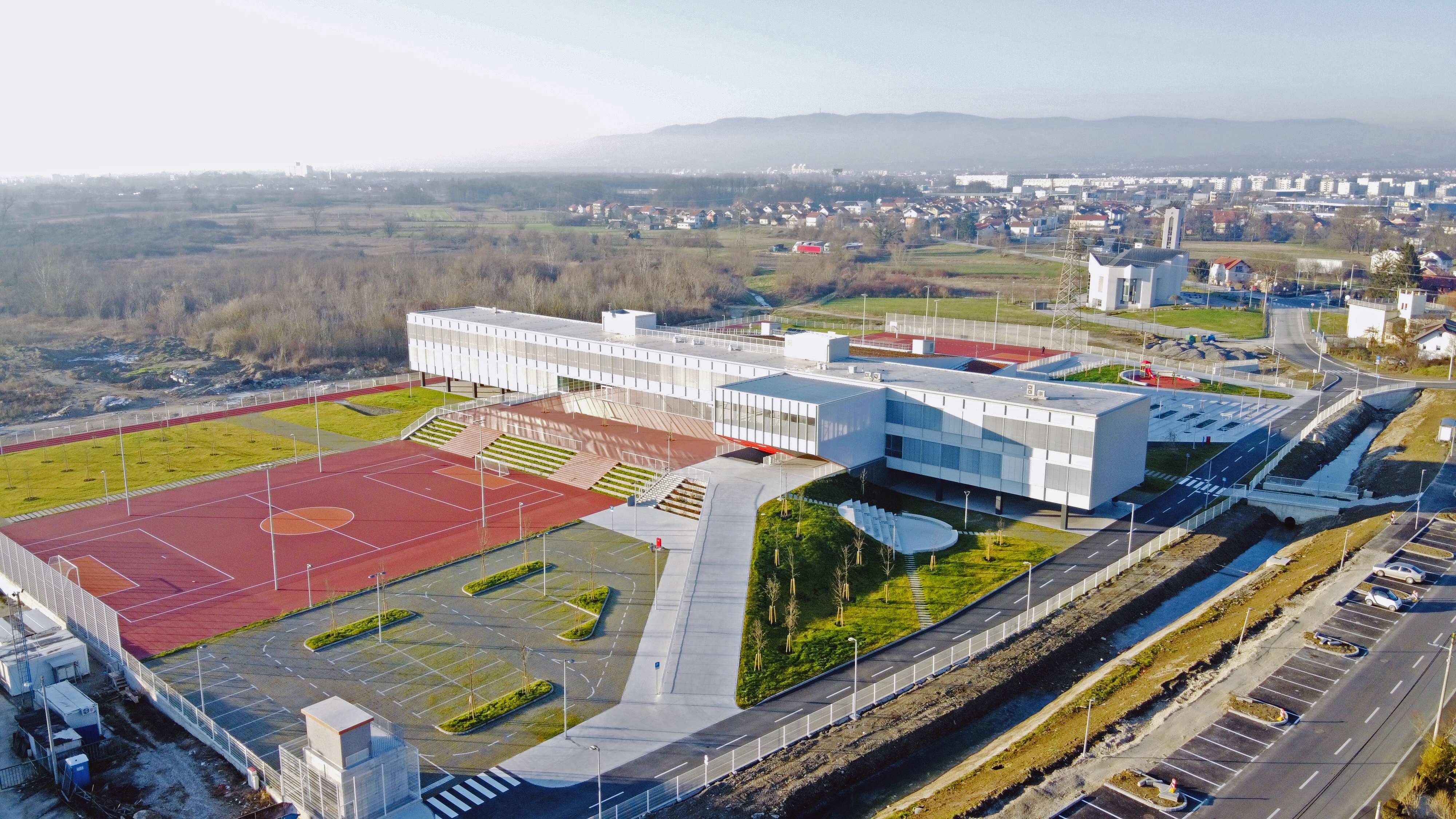
If every elementary school looked as pretty and was as well equipped as Ivanja Reka Elementary School in the south of Sesvete, eastern Zagreb, you could well believe daily attendance would never drop below 100%. Designed by a team of architectural authors (SUBMAP studios Marija Burmas and Ivo-Lola Petrić, and Jakša Kalajžić from JKA Arhitekti), the multi-level main building sits centrally, surrounded by sports, recreation and other facilities creating an impressive view for both those outside and within.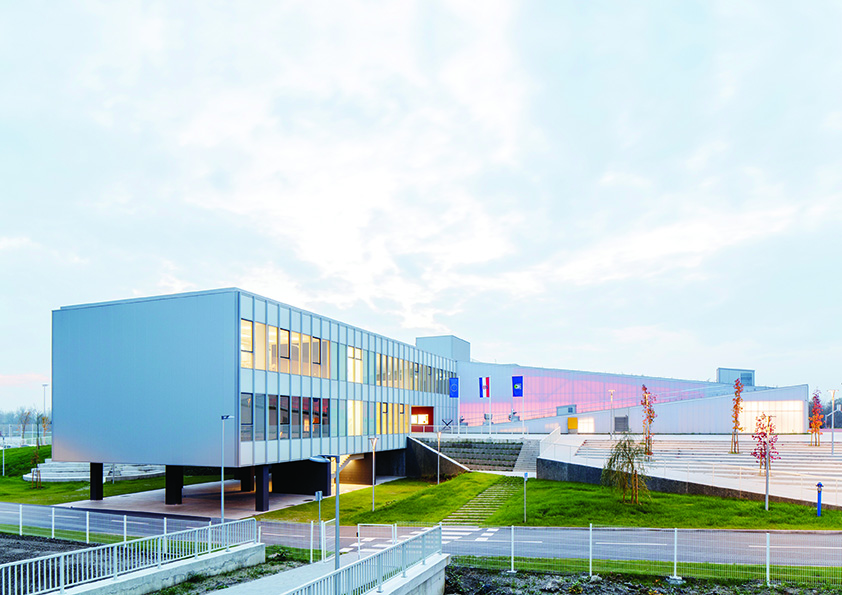 © Ivanja Reka Elementary School / Domagoj Blažević
© Ivanja Reka Elementary School / Domagoj Blažević
Roxanich Wine & Heritage Hotel, Motovun, Istria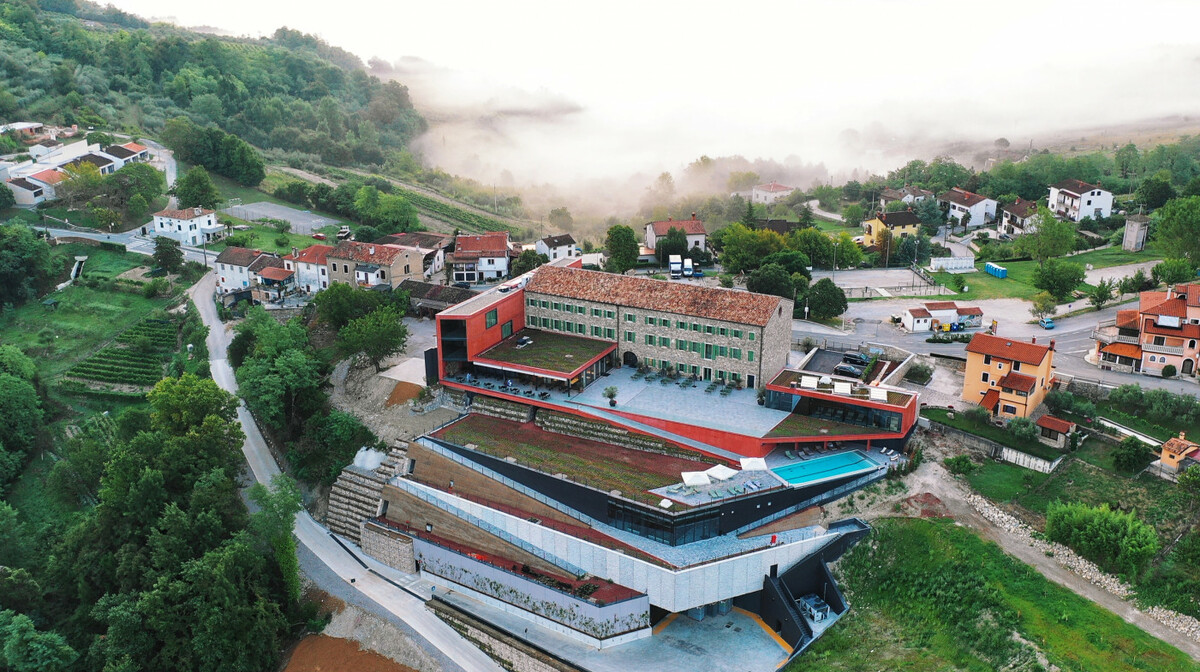
The view is unmistakably Istria. Vineyards carpet the land below and - rising above - the picturesque hilltop town of Motovun. Helmed architecturally by consistently bold Rijeka designer Idis Turato, this multi-level, multi-purpose redesign retains the traditional feel of its existing stone building and its purpose – there's a huge wine cellar beneath – but has opened up the space to give stunning views, not least over a sun deck that spectacularly reflects the sunrise and sunset. This is an active winery, with works and equipment all housed within its lower floors, not that you could tell from the 25 person capacity boutique hotel, restaurant and wine shop upstairs. © Roxanich.hr
© Roxanich.hr
Four Houses for Four Brothers, Diklo, Zadar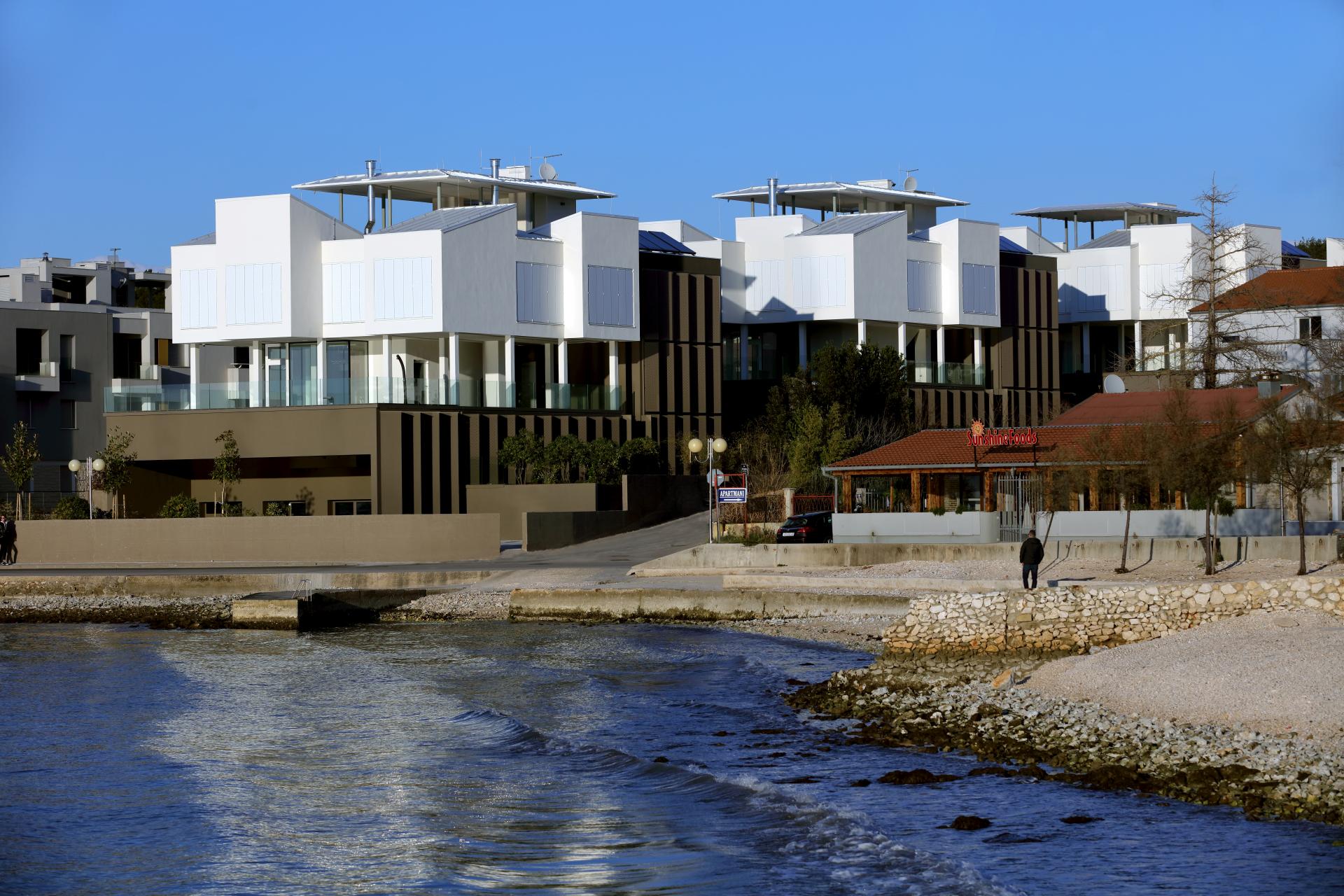
Judging from a theme of project titles used by architects Iva Letilović and Igor Pedišić, we're not sure that Four Houses for Four Brothers was actually commissioned by four brothers or that four live there. But, you could well believe they could. The ultra-modern set of independent houses, located next to a beautiful stretch of coast in a north Zadar neighbourhood, was specifically designed to address a distinctly Croatian reality – how to open up some of your dwelling to seasonal guests while you remain at home. The design separates the buildings clearly into separate quarters which allow privacy, comfort and minimal encroachment for both visitors and residents. © Igor Pedišić
© Igor Pedišić
Galić Winery, Kutjevo
Award-winning outfit Zagreb-based studio Dva arhitekta have an existing, jaw-dropping design for a rural winery commissioned by famous makers Galic. However, that project, as yet, remains unrealised. But, their winery for Galic in the centre of Kutjevo town is complete. Melding the traditional and the contemporary, the upper section of the building is a bold and unblemished red brick, adorned with the winemaker's unmistakable logo. Beneath, concrete arches invite your eyes into the actual wine cellar – neat rows of barrels, protected behind glass walls that are set back from the facade. Brilliant! © Damir Fabijanić
© Damir Fabijanić
Seecel Centre, Zagreb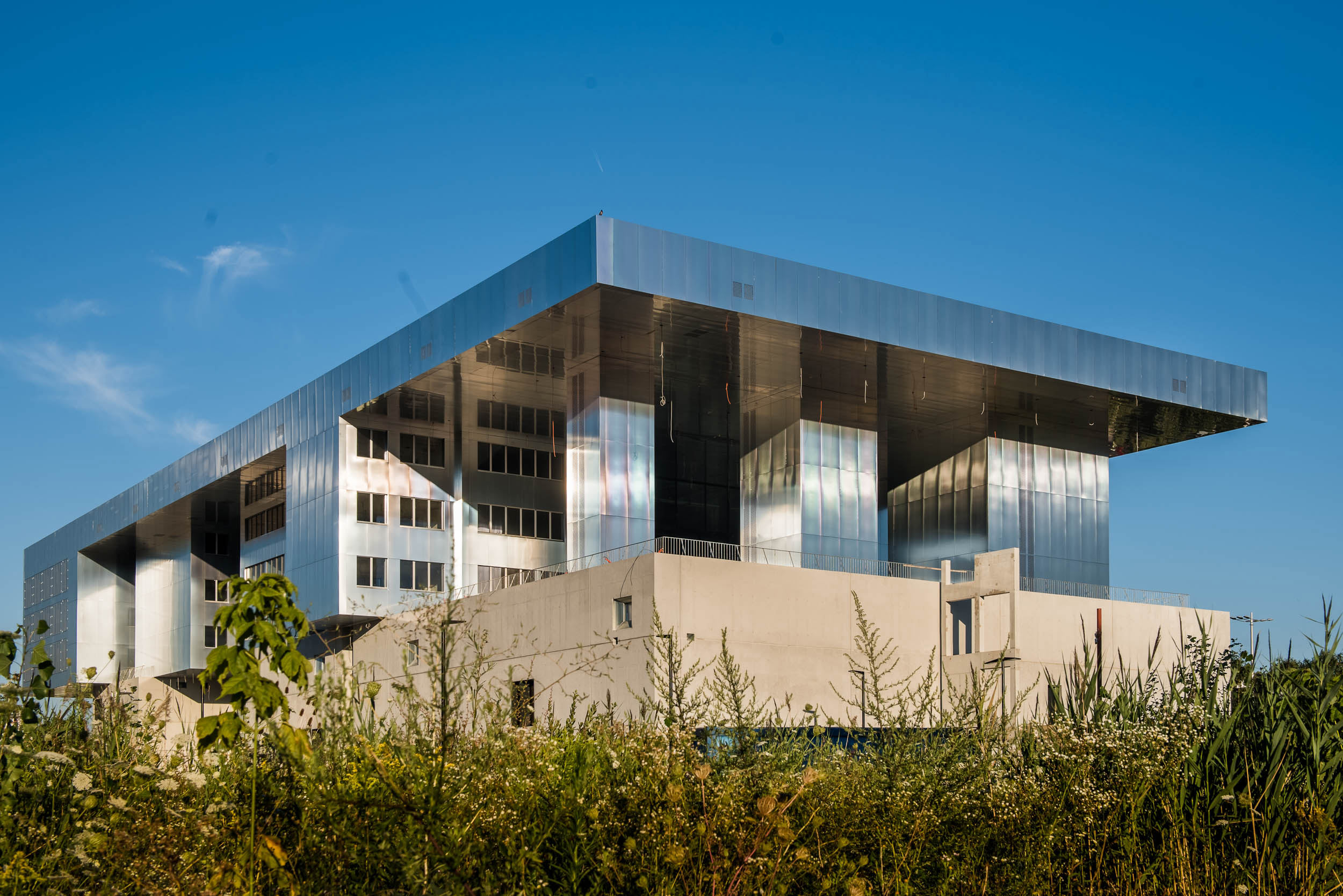
Designed as a regional centre for the development of entrepreneurs and its construction costs generously part-funded by European money, the Seecel Centre arrived long overdue and does not house its intended inhabitants. Such matters are best left for different articles as, here, we're concerned with the undeniable finery of this building's architecture and appearance. Holding space for accommodation, offices, communal collaboration, education and presentations, the five-floored building uses ultra-modern building materials and construction methods to make it low-energy, its great blocks of covered concrete, with glass windows set further back, echoing old fortifications. It was designed by Igor Franić who, in Croatia, is perhaps best known for the Museum of Contemporary Art in Zagreb and completed by him and his team at SZA / Studio za arhitekturu d.o.o.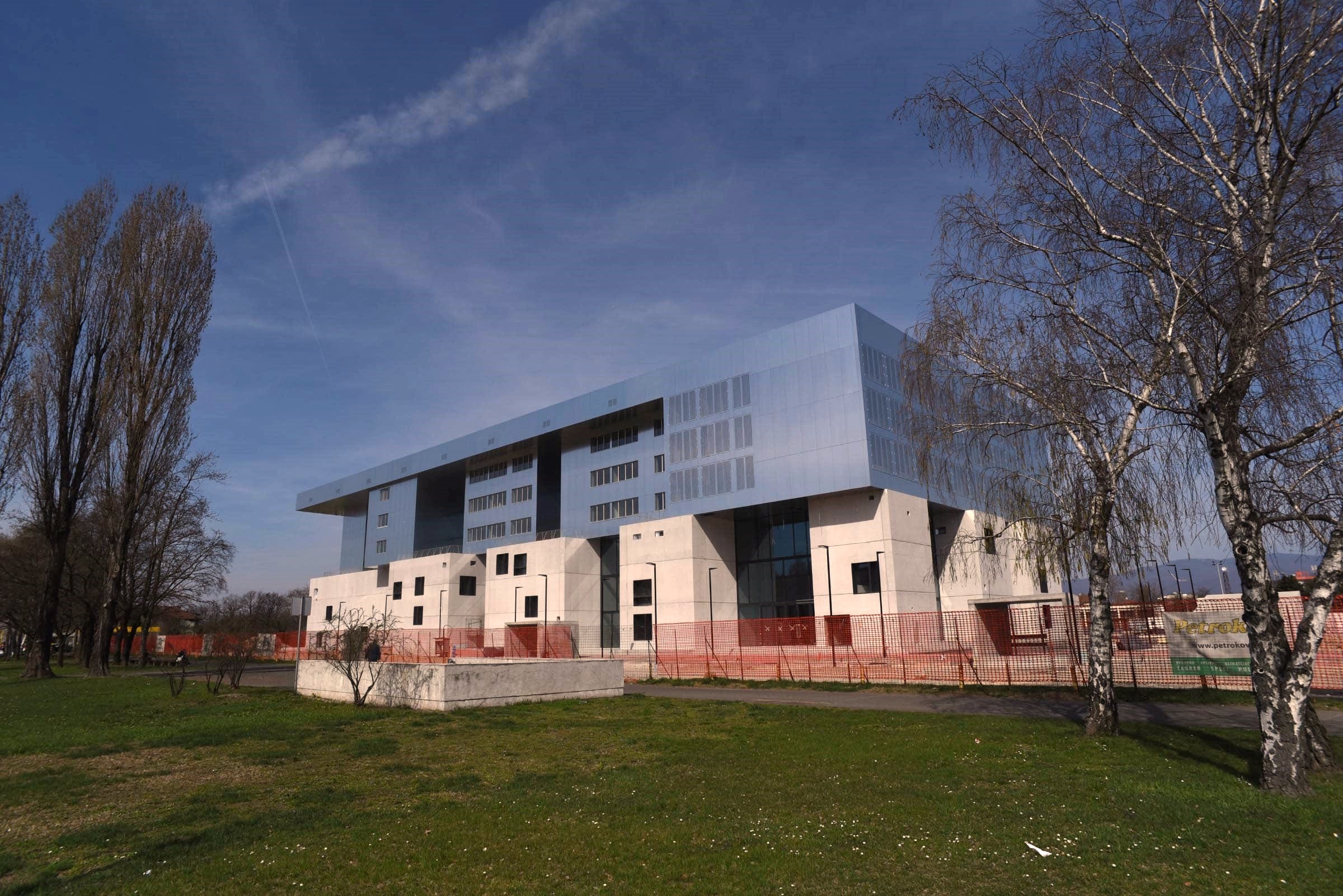 © Site Project d.o.o.
© Site Project d.o.o.
Trg Poljana, Šibenik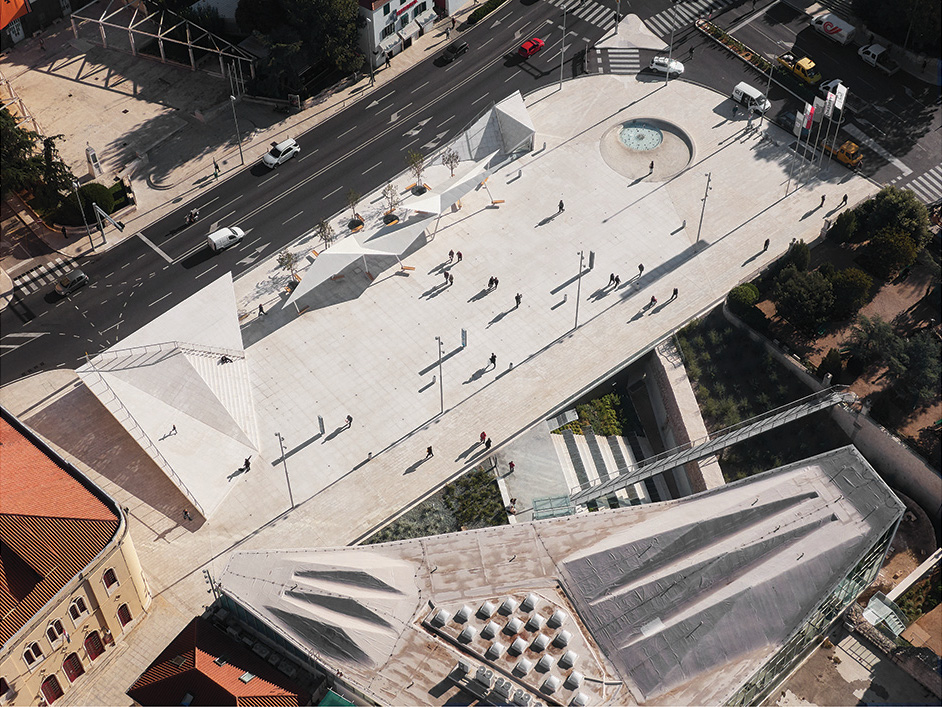
Not a small amount was asked of project architects Atelier Minerva from Dubrovnik in the task to create Trg Poljana in Šibenik. The site had long been earmarked for a much-needed, official town square – a place for events and public gatherings. But, the town was also woefully short on parking. By burying a multi-level car park beneath the open space, the architects successfully met both demands. Triangular shapes sit at an angle above shaded seating, echoing the inclines on the roof of the Juraj Šižgorić City Library opposite. Clever.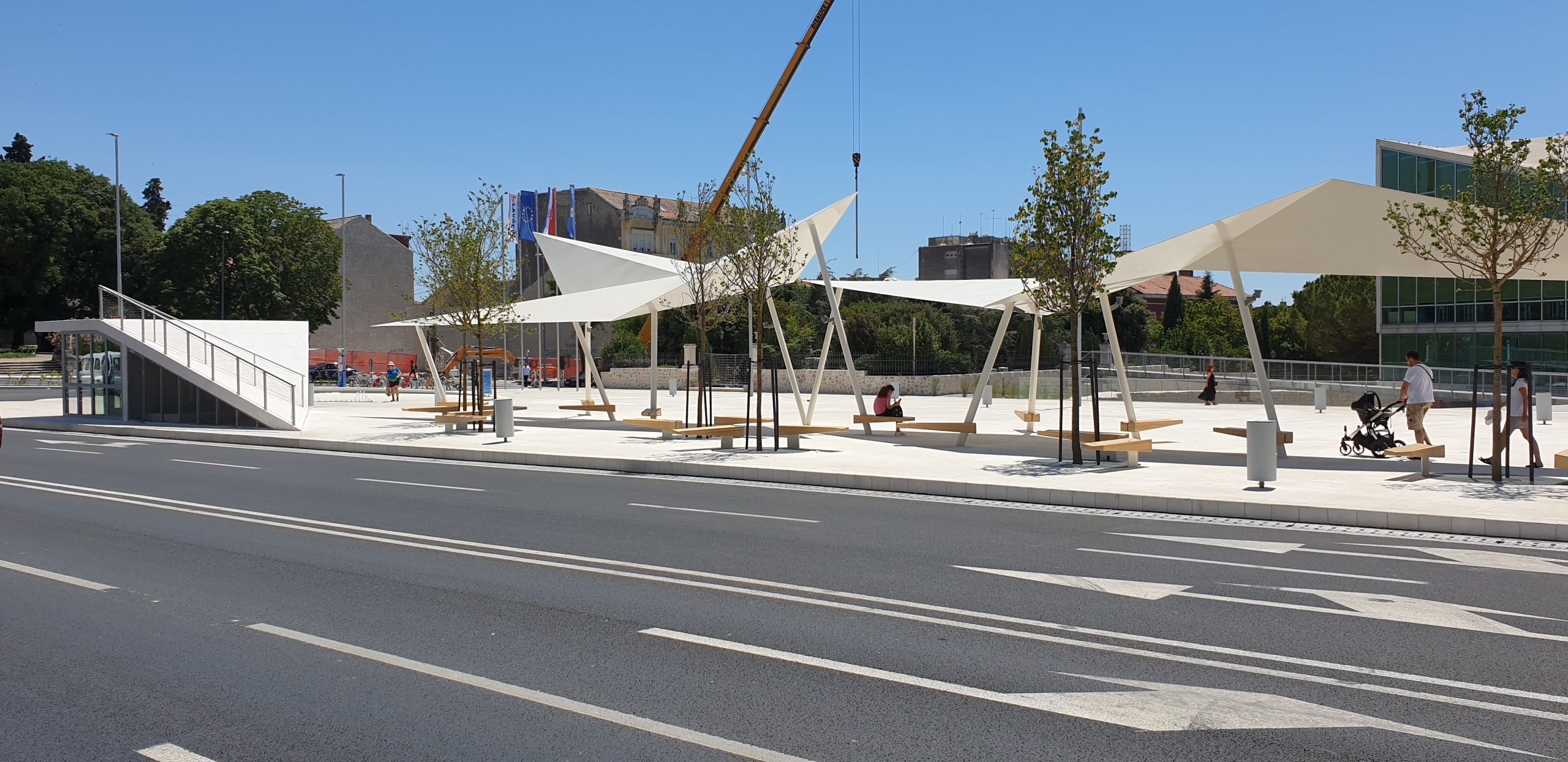 © Ervin Husedžinović / Eccos-inzenjering
© Ervin Husedžinović / Eccos-inzenjering
Homestead on Hartovski vrh, Žumberak, Zagreb County
A collection of multi-purpose rural buildings, Homestead and Meditation Centre on Hartovski vrh was commissioned and designed for use by the Buddhist Center Zagreb. Their aim was to relocate activities such as chan, yoga, meditation, healthy living and teaching to a peaceful retreat outside of the city. Architects Branimir Rajčić and Mariela Žinić began the project in 2015, with the completed site arriving in 2019. Modern building materials are used, but not so the striking collection seems out of place within a partially agricultural setting. The set of buildings includes a residential dwelling and a larger hall for meetings and activities, both of which use large windows to allow the light and nature to flood in. © Robert Leš
© Robert Leš
Square of Traditional Crafts, Varaždin
A tricky task was given to architects Studio Konntra – how to enliven and modernise a traditional old square in the centre of one of Europe's best-preserved Baroque Old Towns. They did this by constructing transportable kiosks to house small outlets for local artists and craftsmen that cater to visiting tourists who come to the square. When occupied during the day, the plain wooden interiors allows the crafts to take centre stage. But, after closing time, the outsides of the wooden doors are brightly coloured and adorned with paintings, a welcoming environment for residents to use at night.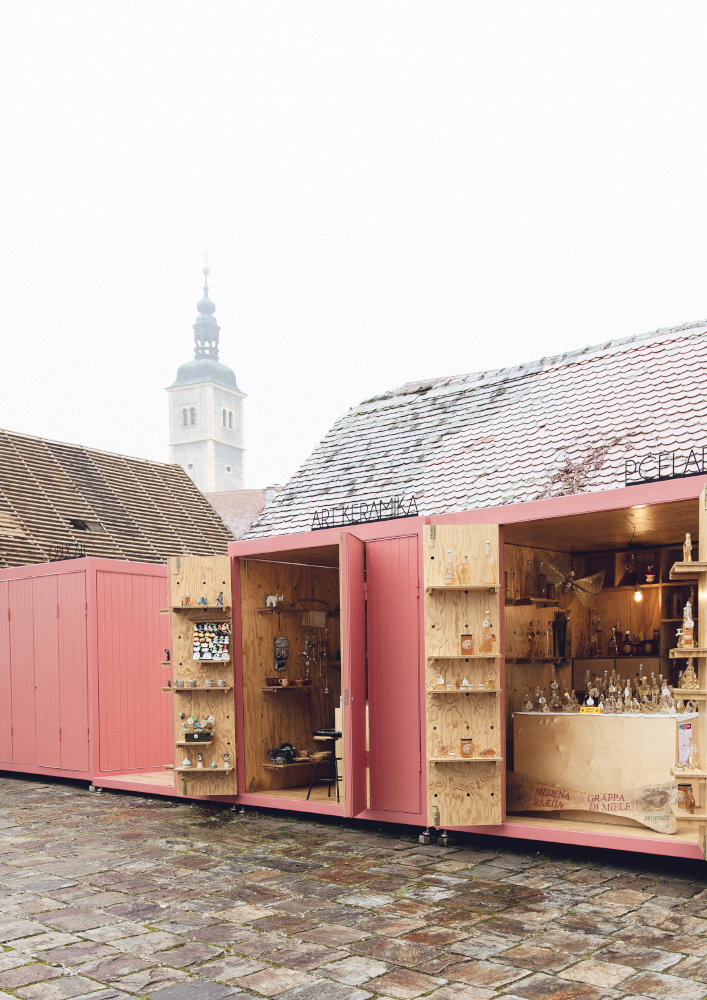 © Studio Konntra
© Studio Konntra
Pozega-Slavonia Hunters Send Two Tons of Game to Earthquake Area
February 2, 2021 – In an admirably understated manner, Pozega-Slavonia hunters humbly pitched in to the relief efforts and sent two tons of game to those in the earthquake-affected area of Sisak-Moslavina
It's fair to say that in this day and age, hunters often get a bad rep. There are far more people in the world today who abstain from eating any meat – vegetarians and vegans – than those who go hunting. Changing times. For sure, it wasn't always this way.
In Croatia, hunting associations play a vital role in maintaining the beauty and accessibility of the country's rural landscape. Not that you much hear about this aspect of their undertakings. Perhaps they are typically just rather understated people?
You might easily come to that conclusion when considering the recent humanitarian action undertaken by Pozega-Slavonia hunters. Organised by the county hunting association and county officials, Pozega-Slavonia hunters from each of the region's district societies contributed in an effort to send the game taken by each – mostly deer and wild boar - to the earthquake-hit areas in Sisak-Moslavina County. They so far managed to send a whole two tons!
At the same time, Pozega-Slavonia hunters from the county association began collecting funds for the families of those tragically killed in the 29 December earthquake. They have so far collected some 50,000 kunas that will be directed to the intended recipients through the Croatian Hunting Association.
“This is a small help, but undertaken with an open heart,” said a representative from the County, who jointly organised the effort.
“We go to visit friends,” he said, in reference to the delivery of the Pozega-Slavonia hunters game, “and a Slavonian does not go empty-handed. We have loaded more than a ton of meat here (in this shipment), but there will be more because in co-operation with Croatian Forestry, Brod-Posavina County and the Radinje hunting ground, today we will take (in total) about three to four tons of game.”
“(Perhaps) the people of Moslavina will remember Slavonia next time they eat Slavonian čobanac (a local specialty stew, made from game) because she (Slavonia) is always thinking of her (Moslavina),” he concluded.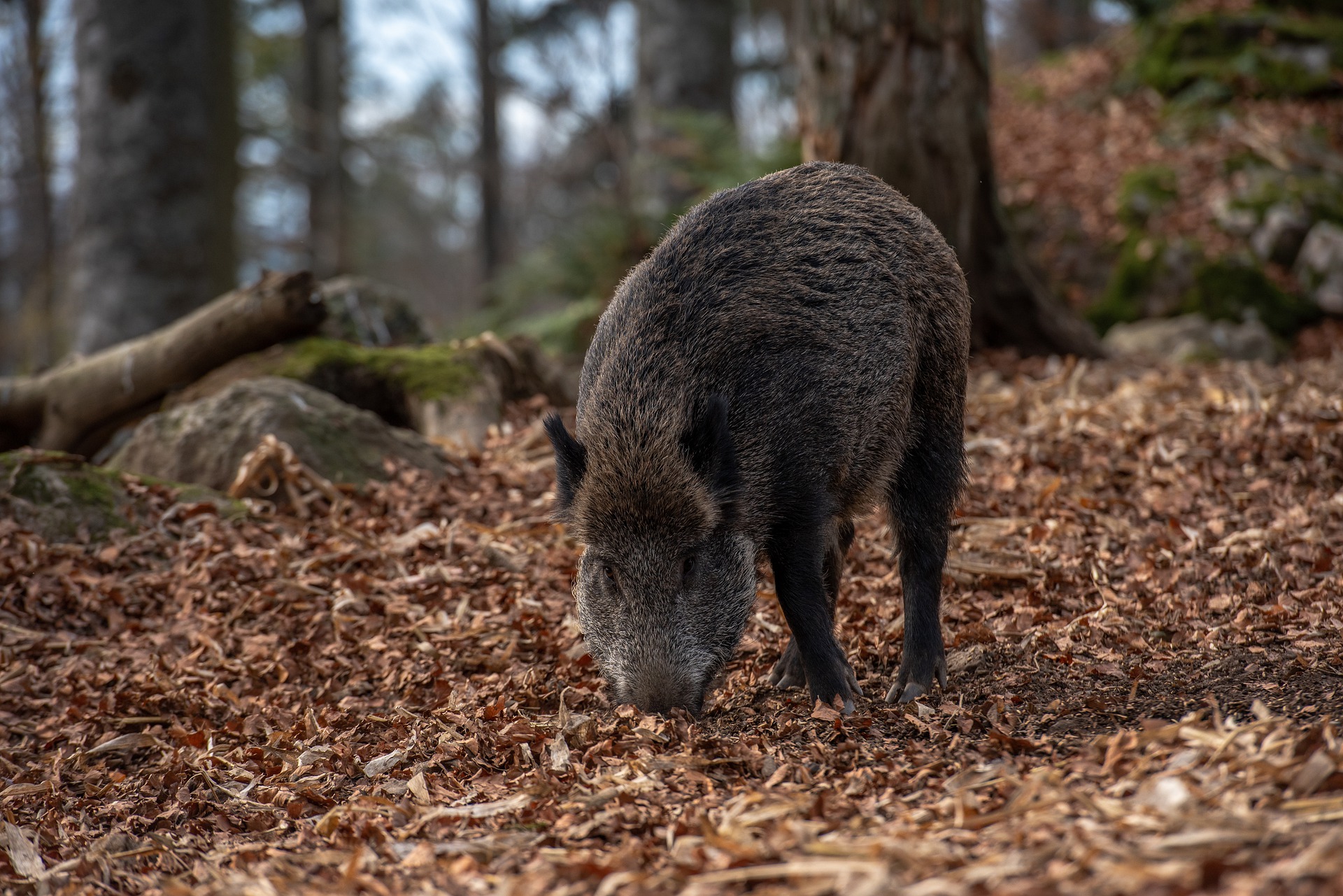
“Lovački savez Požeško – slavonske županije (Hunting alliance of Pozega Slavonia County) was the main organiser,” Mateja Tomasevic, Head of the County office told TCN. “Within it, there are 28 separate societies of Pozega-Slavonia hunters. They all participated in the humanitarian action.”
Among the 28 contributing societies were Hunting Associations 'Fazan' and 'Košuta' from Pakrac, 'Psunj' from Orljavac, 'Šljuka' from Brestovac, 'Jelen', 'Šijak', 'Sokolovac' and 'Sveti Hubert' from Požega, 'Dilj' from Buk, 'Vidra' from Sapna, Čaglin, 'Slavonac' from Kutjevo, 'Strijela' from Bektež, 'Papuk' from Biškupci, 'Sokol' from Bučje, 'Seljak' from Jakšić, 'Vepar' from Kaptol, 'Krndija' from Našice, 'Vranovac' from Vetovo, 'Šljuka' from Pleternica, 'Fazan' from Ruševo, 'Vražjak' from Sesvete, 'Sjeverni Dilj' from Seoce, 'Slavuj Gaj' from Poljana and 'Kuna' from Paka. Over 1300 residents of the county belong to one of the Pozega-Slavonia hunters associations.
Bravo!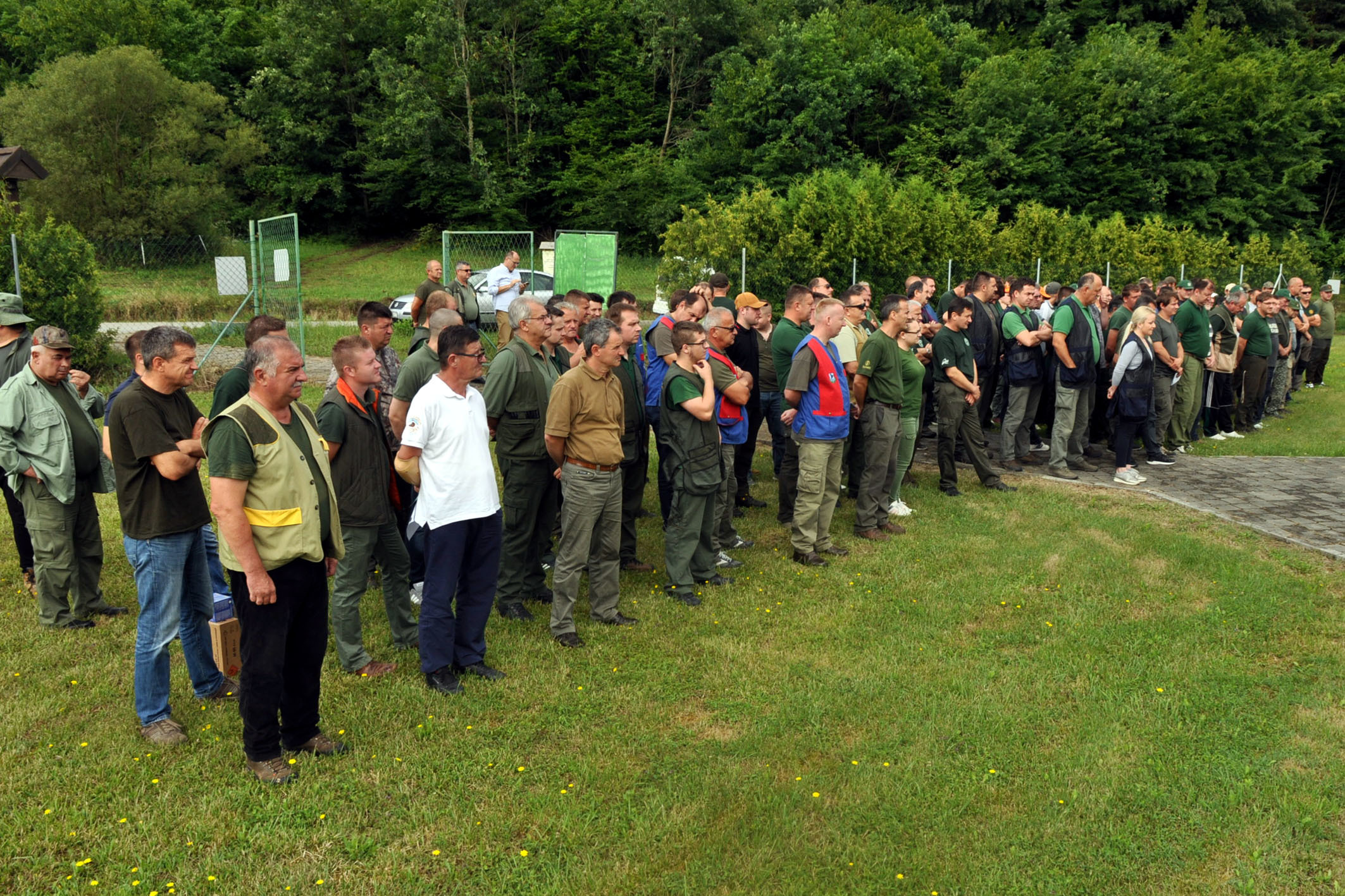 Some of the members of the Hunting Associations of Pozega-Slavonia County © Hrvatski Lovački Savez
Some of the members of the Hunting Associations of Pozega-Slavonia County © Hrvatski Lovački Savez
For the latest travel info, bookmark our main travel info article, which is updated daily.
Read the Croatian Travel Update in your language - now available in 24 languages
Join the Total Croatia Travel INFO Viber community.
First Gay Marriage Held in Kutjevo, Heart of Slavonia
November 5, 2020 - The first gay marriage held in Kutjevo was between locals from the area of Čaglin Municipality.
As the city clocks struck midday, two men, locals from the area of Čaglin Municipality said goodbyes to their single selves and embraced their future together as husband and, well, husband. Their affirmations were heard in front of the registrar of Kutjevo and thus, officially, they became partners in a same-sex marriage. It was the first gay marriage to take place in Požega-Slavonia County.
Portal Požega.eu reported that the intimate marriage ceremony of the 47-year-old and his 32-year-old partner took place over recent days, far from the gaze of the public. The ceremony was a quiet and private affair. In rural areas like Požega-Slavonia County, such marriages are not always met with widespread approval. The city registrar reported that this was the first gay marriage they had been asked to witness, despite having been in the job for many years.
Though this may be the first gay marriage to take place in Požega-Slavonia County, hundreds of same-sex marriages have concluded in Croatia since 2014, when the Life Partnership Act came into force. In the time since then, male same-sex marriages in Croatia have been slightly more common than female ones. The largest number of such marriages took place in Zagreb. From published figures outside of Croatia, where same-sex marriages have been more commonplace over a longer period of time, same-sex marriages are frequently more stable with fewer ending in divorce compared to traditional marriages.
Life partnerships in Croatia
The first same-sex marriage in Croatia was concluded in August 2014, and despite the great interest of the public, the two male partners managed to keep the wedding a secret. Just like the couple from Kutjevo. The couple married in the first of the ceremonies in Croatia only went public with details just last year.
"I was very nervous in those days, it was a historic thing after all. If we could not have done it in Croatia, we would certainly move to a country where it was possible," one of the spouses, Ivan Zidarević, told 24sata, adding that society has changed for the better with the change in the law.
Zidarević said he believes that Croats are tolerant of gay couples. Their marriage ceremony in 2014 was witnessed by two registrars, godparents, several friends, but also the then-Minister of State Administration, Arsen Bauk, initiator of the Croatian Life Partnership Act. Bauk gave the couple a symbolic gift – a pair of ties.
According to the Law on Life Partnership of Persons of the Same-Sex, a life partnership is a family community of two same-sex persons concluded by the competent authority (a registrar). The process of concluding a life partnership in Croatia is very simple. It is necessary to report to the registrar, who then checks whether the preconditions for concluding a life partnership have been met and takes a statement on the choice of surname. After that, the time and place of the ceremony are agreed, which, along with the registrar and partners, takes place in the presence of the godparents.
Happiness despite condemnations
At the beginning of this year, the Constitutional Court decided that same-sex couples in Croatia have the right to be foster parents under the same conditions as everyone else. However, the current constitutional definition of marriage in Croatia does not include same-sex families. A change to legally recognise married same-sex partners in this way was this year demanded by the participants of Zagreb Pride, held on September 19, 2020. Pride organisers said that without a change in the recognition, state authorities are still restricting the rights of gay people and making them second class citizens.
In many EU countries, and more so in Zagreb here in Croatia, same-sex marriages are acceptable and almost every day. But, in rural areas such as Požega-Slavonia County, Kutjevo, and other places like these, such marriages are still of great interest and not universally embraced.
Although they live in an environment where they might encounter condemning views, the happy couple from Požega-Slavonia County decided to legalize their relationship. In comments on Facebook, people wished them luck, and one commenter jokingly wrote: "If they didn't make a toast with Graševina, they didn't do anything. Congratulations anyway!"
For the latest travel info, bookmark our main travel info article, which is updated daily.
Read the Croatian Travel Update in your language - now available in 24 languages
One Thousand Bottles of Wine to be Filled for Aurea Fest Pozega!
August 25, 2020 - Aurea Fest, which will be held in Pozega from August 28 to 30, 2020 with strict epidemiological measures, is a traditional event held in the Kutjevo cellar.
Eight hundred bottles of premium Graševina Kutjevo and 200 bottles of red wine Maximo Nero from last year's harvest will be filled for the occasion. Dino Galić, a member of the Management Board of Kutjevo d.d., reminded of 2019 when the Požega festival successfully celebrated its fiftieth birthday, and Kutjevo achieved a record year with over five million liters sold in the domestic and foreign markets.
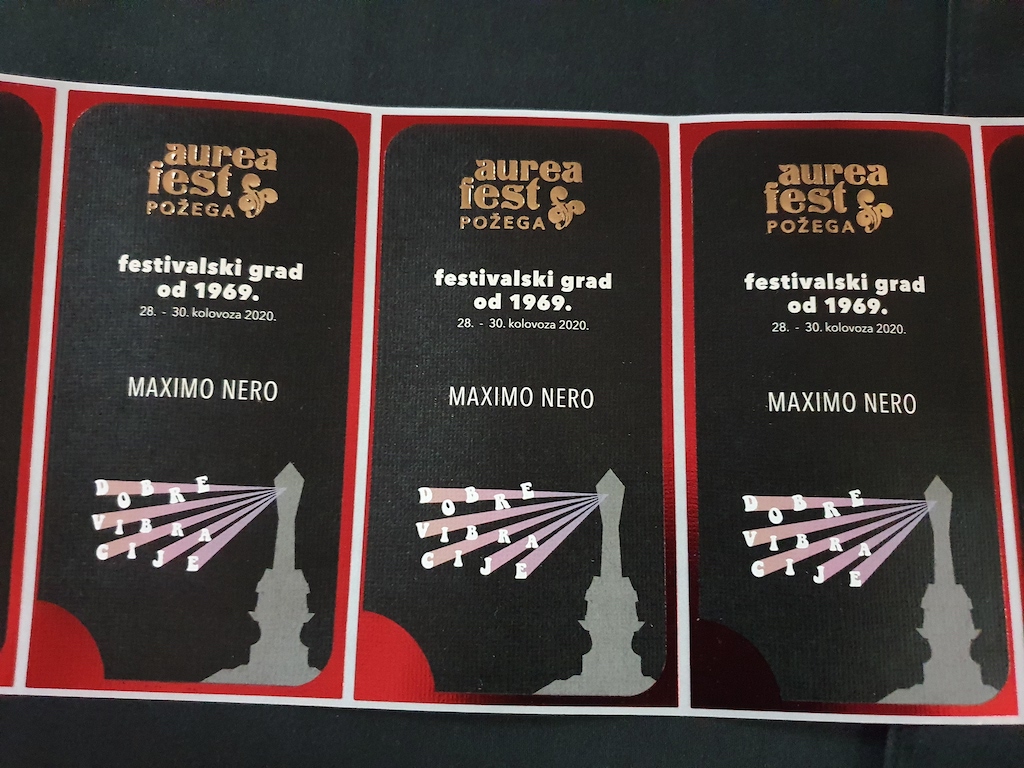
"The spirit of the winery and the festival will not stop, we remain partners and with this wine filling, we will start Aurea Fest Požega," Galić pointed out.
The City of Požega is the sponsor of the festival and Darko Puljašić, Mayor of Požega and Member of Parliament, thanked Kutjevo for their partnership.
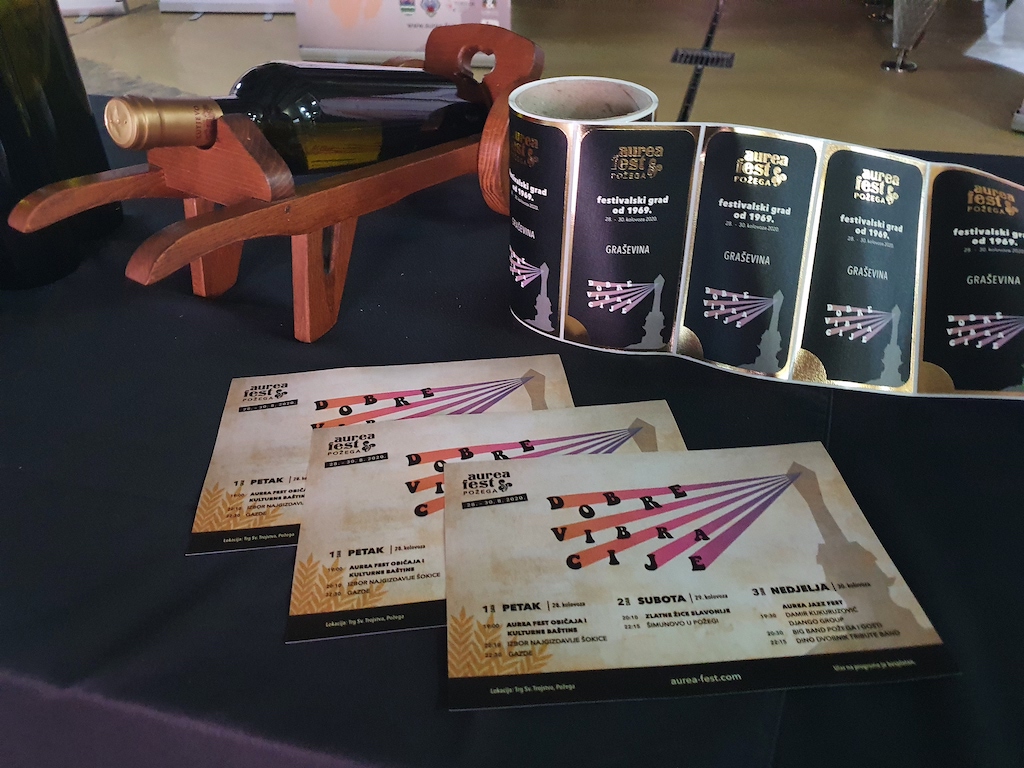
"We perform and fight together. We in Slavonia have always been brave and struggled with adversity. At the festival, we will show the Slavonian soul, and with it comes a good refreshment - Kutjevo wines, which the whole world knows. Let's stay positive in spirit, and negative in coronavirus," said Puljašić.
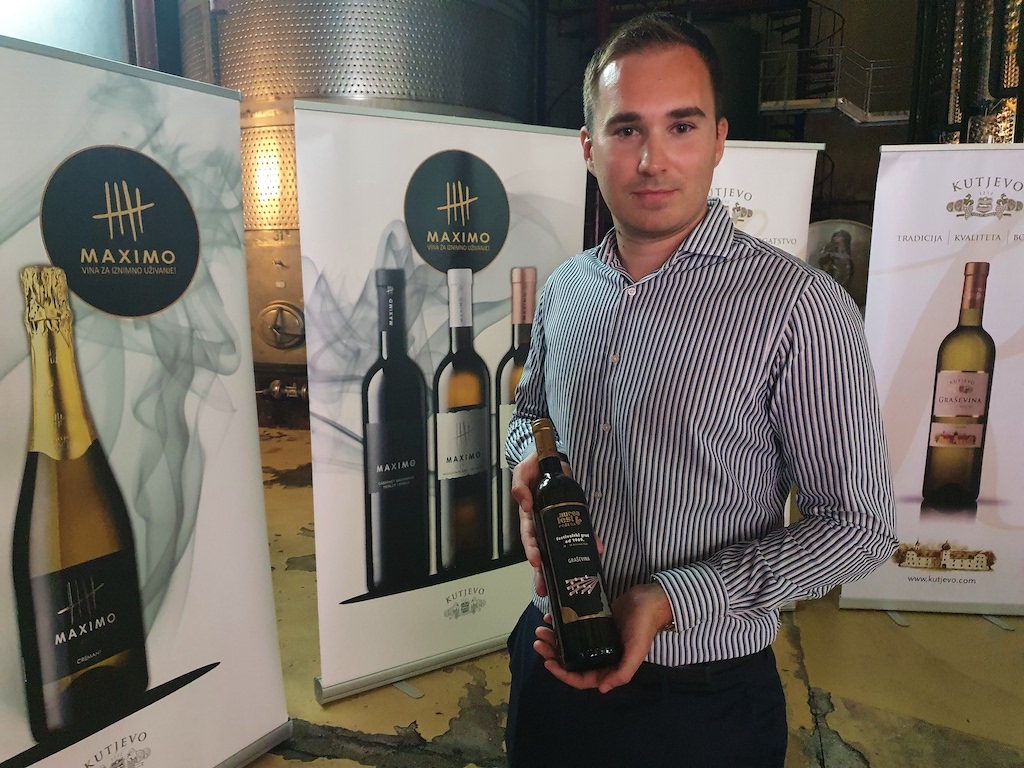
The organizer of the festival is the Association Aurea Fest Požega, whose director Ivan Bunjevac said that the association as the organizer will do everything to make the festival successful and thanked Mayor Puljašić for his support.
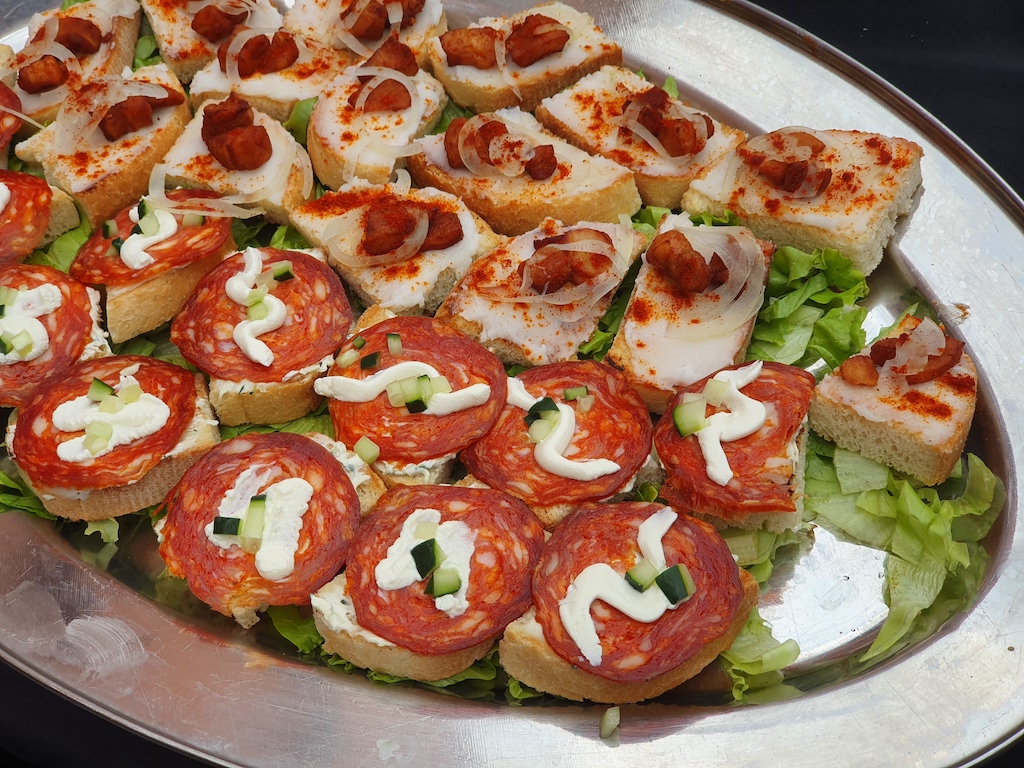
"Good vibes from Požega go further and we are expecting you this coming weekend," said Bunjevac. This was followed by symbolic labeling of the festival wine, in which the speakers were joined by Anamarija Blažević, Mayor of Pakac and Member of Parliament, Deputy Mayors of Požega Mario Pilon and Ferdinand Troha, Director of the Požega Tourist Board Silvija Podoljak, Mayor of Kaptol Mile Pavičić, Deputy Mayor Ivica Potočanac, representatives of the Croatian Radio and Television, local media and members of the Trenkovi Panduri Historical Unit.
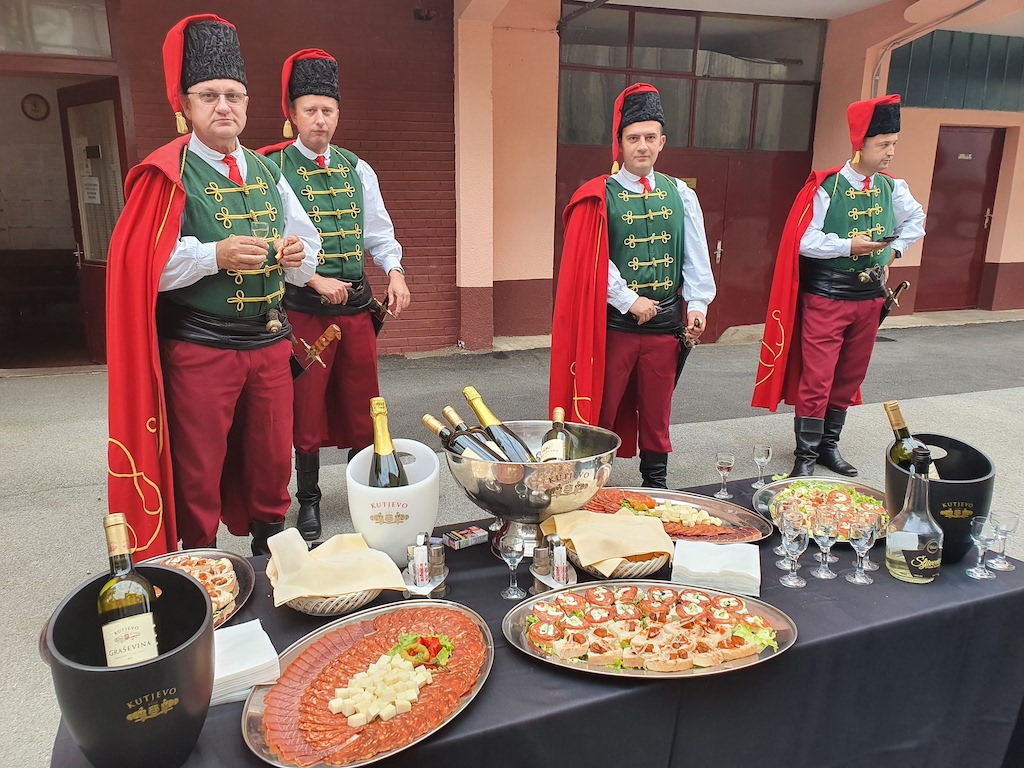
In the second part of the conference, this year's program was presented by Damjan Pirović, artistic director of Aurea Festa Požega, while Podoljak, marketing director of Aurea Festa Požega, invited participants and guests to adhere to epidemiological measures and invited citizens to follow the festival through the official website.
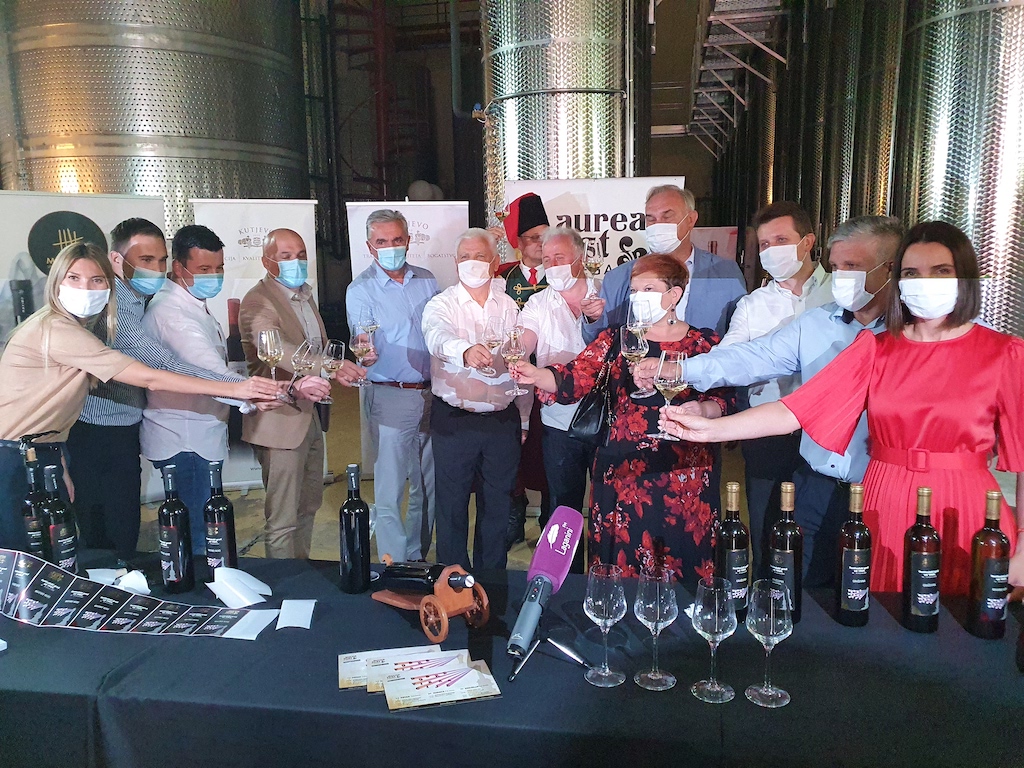
For the latest travel info, bookmark our main travel info article, which is updated daily.
Read the Croatian Travel Update in your language - now available in 24 languages
Join the Total Croatia Travel INFO Viber community.
Kutjevo Continued Working at Full Capacity Despite Lockdown
As Novac/Matea Grbac writes on the 19th of May, 2020, although the domestic and world economies are gradually opening up again, and people's lives are returning to a slightly altered sort of normalcy, the Croatian economy is still far from out of the woods. Kutjevo has set job preservation as one of its main strategic goals in these strange times.
In these moments of crisis caused by the coronavirus pandemic, preserving jobs has become the biggest challenge for each and every employer. Day by day, we're witnessing the devastating statistics on the growth in the number of unemployed people, of which there are currently just over 160,000 in terms of the Croatian labour market.
In addition to those who simply lost their jobs practically overnight, more and more workers are on the state-guaranteed minimum wage introduced by the Croatian Government in a package of economic measures designed to keep the Croatian economy's proverbial head above the water. Despite the uncertainty and the fact that it is already clear that the plans for this year are one thing, and their actual implementation is something else, one of the most important agricultural producers in Croatia, Kutjevo, has set job preservation as one of the main strategic short-term and long-term business goals. It is for this reason that the Kutjevo winery has no intentions of encroaching on the rights of 622 employees.
''We have 593 full-time employees and 29 part-time ones. Preserving their jobs while also preserving financial stability and uninterrupted production processes is our business priority because the main seasonal work and preparations for harvest that awaits us at the end of August take place on arable land and on vineyards,'' explained Kutjevo Management Board member, Dino Galić.
He pointed out that for now, they have applied only for job preservation measures and that workers' salaries have not been adjusted, but kept at the level they were at before the coronavirus pandemic hit the country, in order to preserve their standards and the respective household budgets of Kutjevo's employees, a move they're extremely (and rightfully) proud of.
''So far, we haven't utilised any of the other measures offered by the Croatian Government to businesses. We believe that as a large system, we have a responsibility to all public and private institutions to fulfill all of our obligations on time. Of course, as long as the financial construction of the business allows that to happen. We're actively monitoring the development of the situation and we're being informed and consulting with all of the relevant institutions regarding possible frameworks and support on a daily basis,'' he emphasised.
In addition to its workers, Kutjevo also takes care of a large subcontracting base within which it has contracted cooperation with as many as 242 farms that take care of a massive 370 hectares of vineyards. Therefore, this well known Croatian company is constantly trying to make consumers aware of the importance of buying and consuming domestic products above all, thus indirectly providing support to the survival of Croatia's many producers.
Kutjevo has stated that even during these economically trying times, they still worked at full capacity and that due to the nature of the work, most of their employees still came to work physically as normal.
''Since we're a company whose primary activity is agricultural production, we worked at full capacity, of course, in compliance with all of the prescribed measures of the National Civil Protection Headquarters in order to protect the health of our employees at the maximum level. I must also point out the contribution of all of our colleagues who, through their efforts and hard work, ensured that work taking place with field crops and in vineyards was done within the given deadlines,'' he emphasised, adding that like many other companies across the country, office work and work related to sales and marketing was organised in a way so that people could work from home.
The closure of the HoReCa system, the plethora of coronavirus-induced economic issues, the rise in excise duties on alcohol and tobacco products - all these represent challenges that the wine industry has faced this year, and we're only in May. In addition to all of these troubles, Galić stated that according to information from the sales index, the growth of wine sales in retail chains is visible, but this data still doesn't go in favour of domestic winemakers. Namely, although the growth is visible, it is more related to imported wines which come in lower price categories, and the sales of top wines from Croatian wineries are unfortunately continuing to decline.
Despite the less than encouraging numbers, they still see something positive in everything. It is precisely the growth of online sales that has flourished in the last two months. Along with the growth of e-commerce, a positive shift, he added, is also visible in the gradual change in the habits of local consumers who seem to be beginning to appreciate quality domestic products more.
''Changes in consumer habits have been visible for a long time. Croats are becoming more and more educated about wines, as well as in pairing that drink with certain meals, thus raising the bar for local winemakers. This is an excellent indicator for us because, in line with this trend, we're constantly investing in production processes in order to achieve better quality,'' explained Galić.
Kutjevo winery, known for its "queen of the cellar", Graševina, sells sixty percent of its wines on the domestic market through hotels and restaurants, which is why it views the reopening of the HoReCa system positively. For example, last year alone, they sold a little more than five million litres of wine through this sales channel on both domestic and foreign markets alone.
''Without caterers and hoteliers, the viticulture sector has no chance to sell wine and maintain the current dynamics. Wine is mostly consumed at gatherings such as celebrations, concerts, weddings and other occasions. We're currently making additional efforts to prepare for the season ahead, despite a large number of questions and unknowns hanging over our heads. We're obliged to deliver the top level of quality to our partners and consumers, regardless of the economic situation through our wine assortment and our service, which we're extremely proud of,'' concluded Kutjevo's Galić.
For more, follow our business and Made in Croatia pages.
Kutjevo Celebrates Vincelovo 2019
There is just one St. Vinko, but a lot of Vincelovos! Nevertheless, the largest and the best-known celebration of the feast of the famous saint in the Požega’s Golden Valley is traditionally organised by Kutjevo.
The picturesque Vinkomir vineyard hill, high above the town of Kutjevo, suddenly becomes alive and awakens all the good spirits of the magic of taste and smell of high-quality young and mulled wines. And not just wines, but of everything which Slavonia has to offer. Local and international guests could also try to grill and taste the Slavonian sausages, enjoy the deliciously roasted carp halves, enjoy the lamb and ox meat on a spit and some homemade cakes. Immediately after the arrival, the guests were presented with glasses in order not to "suffer" while sausages were grilled and for the whole experience to be complete because that is precisely what hedonists really love. Helped by the musical programme presented by cultural societies Bektež from Bektež and Poljadija from Grabarje, the Slavonian atmosphere was guaranteed!
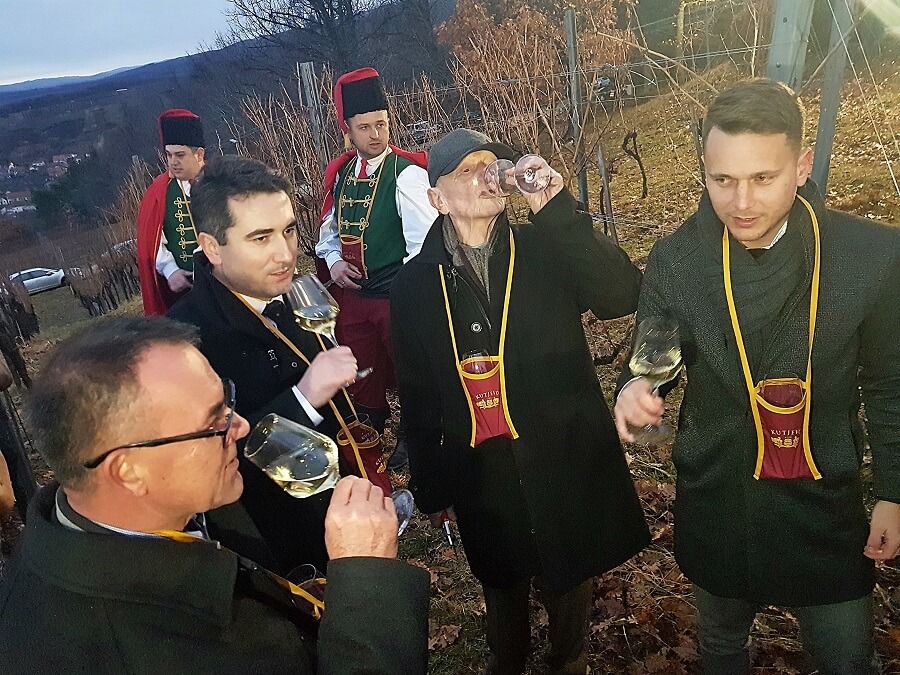
From the beginning of times, people always needed to prune their vines and bless their vineyards, and then to drink good wine in order to make the vineyards produce a lot of grapes that year. It appears that last year's prayers to St. Vinko were very much heard since sales records have been broken.
As in previous years, Enver Moralić, the majority owner of Kutjevo, was joined at this festive event by former president Stjepan Mesić, as well as Alojz Tomašević, the prefect of Požega-Slavonia County; Josip Budimir, the mayor of Kutjevo; Josip Ređo, the CEO of Kutjevo. Kutjevo parish priest Marijan Đukić blessed the event.
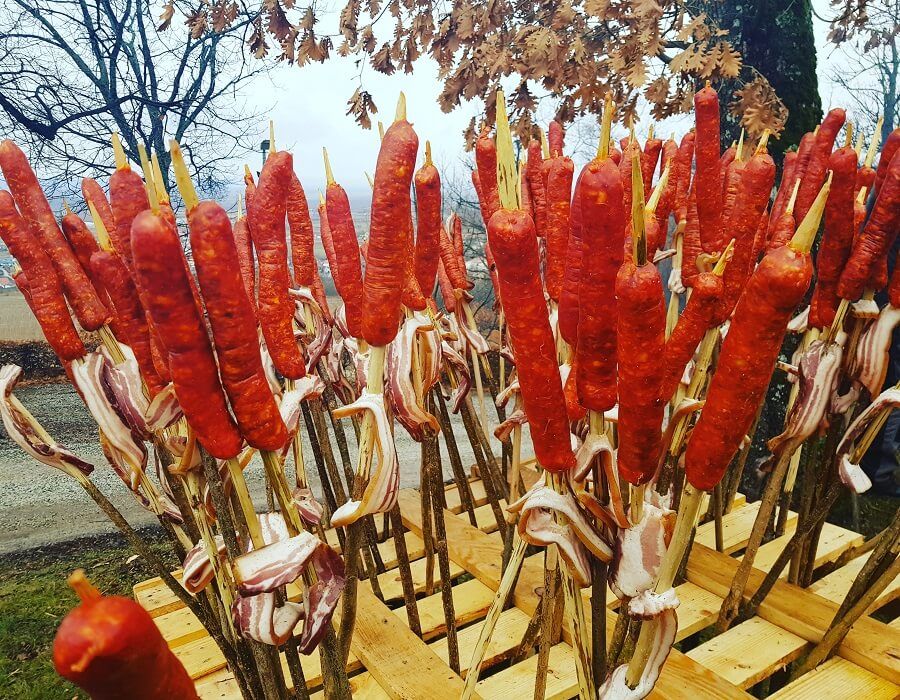
"This past year was filled with many medals won at both domestic and foreign wine competitions, and we sold the record five million litres,” said Ređo at the start of the event in a specially constructed VIP tent.
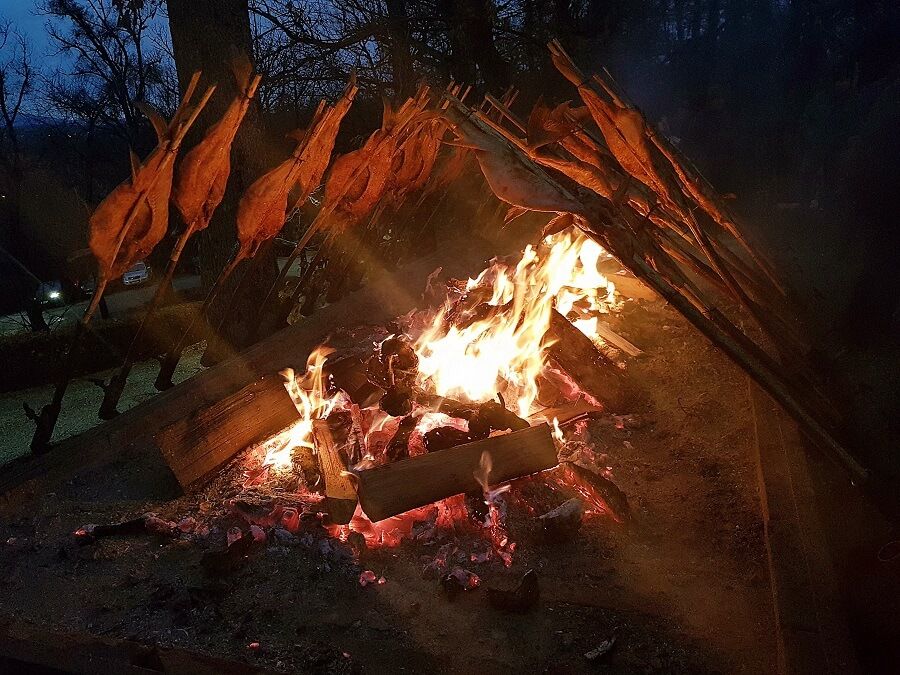
Of course, this year's Vincelovo was an excellent opportunity for the famous winemaking giant to thank all the friends and business partners for their loyalty, as well as journalists from all over Croatia who have been following the company for years and have faithfully reported on all of its impressive achievements.
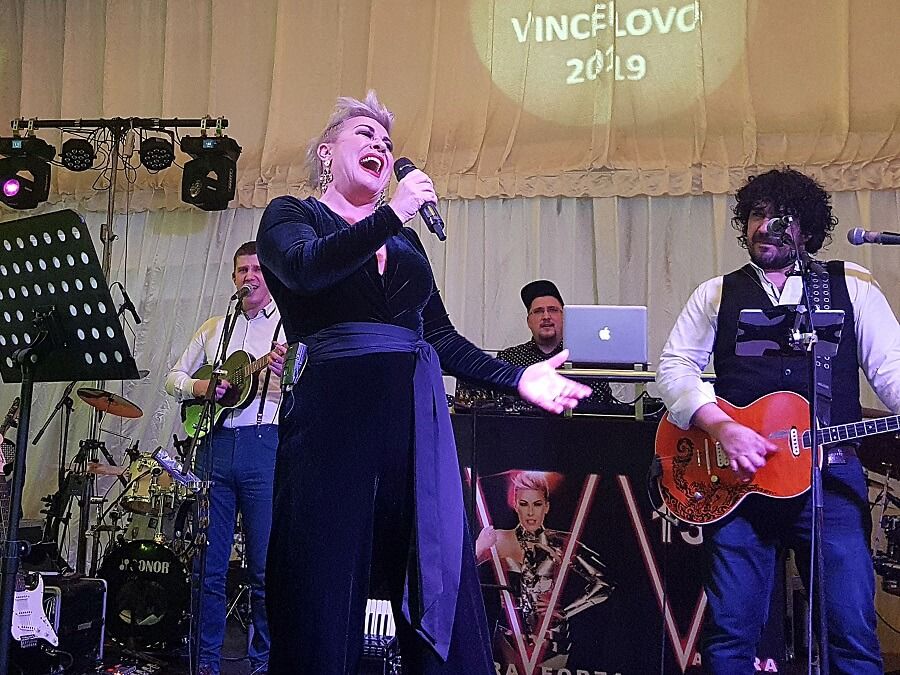
More than 700 guests enjoyed the Slavonian specialities and the young wine, with the festive atmosphere being provided by joyful Indira Forza (who did not forget to praise the juicy sausages), and the Dyaco tamburitza band. The true Slavonian feast lasted until the early morning hours, with people enjoying the wines, dancing and listening to tamburitza music. As always at the Vinkomir, people wined and enjoyed themselves throughout the night.
More news on the Croatian wines can be found in the Lifestyle section.
Could Slavonia be Transformed into Croatian Tuscany?
Could Slavonia become Croatia's very own Tuscany through the story of its local wine? Possibly, as Kutjevo has seen a massive 54 million kuna investment into its new area.
As Poslovni Dnevnik writes on the 11th of November, 2018, on Friday in Kutjevo in Slavonia, a new investment in the Galić winery worth a massive 54 million kuna was presented, the huge investment will increase the winery's capacity by as much as one-third, as they announced.
Of the 54 million kuna, 35 million kuna was invested in the building itself and another 19 million kuna into the equipment. Winery owner Josip Galić pointed out that the winery will remain a boutique winery, and will follow all the current trends, continuing to produce quality wines, rather than focus on mass production.
"Although our winery could be considered a miracle of modern technology and has equipment that even the world-renowned wineries would envy, we're just starting to build our story in Kutjevo. The ultimate goal is to develop the whole region, we want to make a Croatian Tuscany out of Slavonia, as it justifiably deserves it,'' explained Josip Galić, the owner of the winery. The CEO of Galić wine, Andrej Markulin, pointed out that this year, the winery is celebrating ten years of business and wants to intensify its production of "serious" wines in the long run.
The winery in Slavonia looks simply like brick and concrete, but attracts tourists and wine lovers from all over the world, and the attraction is intensified just by viewing the interior and getting to know the equipment that the world's best manufacturers are currently offering.
"With new technology and equipment, we have all the conditions [available to us] to achieve this goal very quickly," he pointed out. The winery began with seven hectares of vineyards and 30,000 bottles of wine. Today, there are 55 hectares, and some of the grapes are from local wine growers.
The capacity of the new winery is 630,000 bottles, which is 30 percent more than there is at the minute, and their annual production is 330,000 litres. In addition to wine production and grape growing, Galić launched chestnut and blueberry growing this year, into which there will be an additional investment of 8.5 million kuna.
Want to keep up with more news like this from Slavonia and from across the country? Make sure to follow our lifestyle and Made in Croatia pages for more.
Kutjevo’s New Wine Wins Decanter’s Bronze Medal
Maximo Oro 2016 wins a major prize in its first appearance at the Decanter World Wine Awards.


